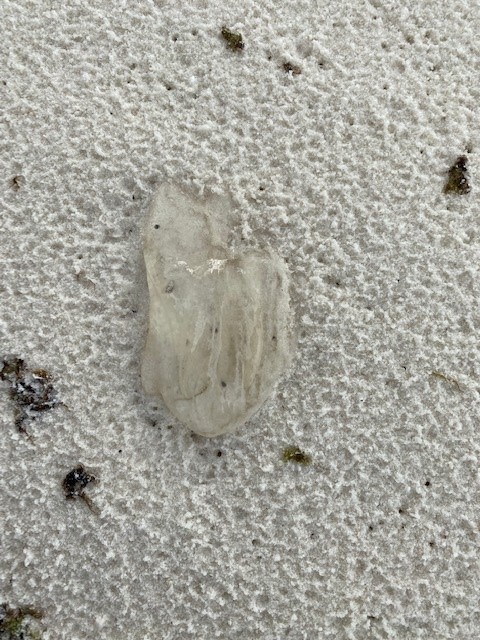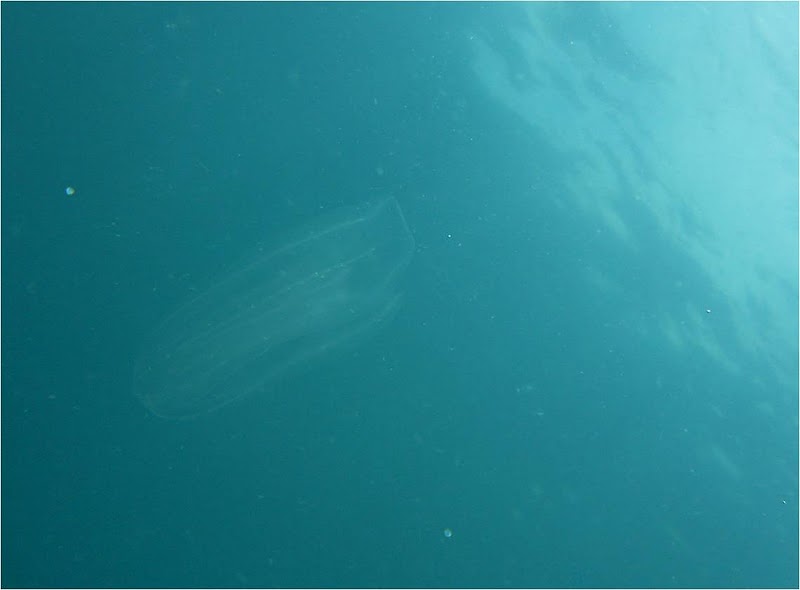Recently I was walking along the shore of Santa Rosa Sound near Park West searching for horseshoe crab nesting. I did not find any nesting activity, but the beach was covered with small comb jellies. These creatures reminded me of my childhood days on Pensacola Beach when we used to throw them at each other – “football jellyfish” we would call them. Now that I am an adult, I understand throwing comb jellies was not a good thing, but as a kid it was the thing to do. I mean, these are jellyfish that do not sting. How cool is that. It occurred to me that many reading this article also experienced comb jellies as a kid the way I did, but probably know very little about the animal that was bringing them enjoyment. So, let’s learn a little more about this magical creature.

The typical jellyfish we encounter at the beach is in the Phylum Cnidaria. They have gelatinous bodies made of a material called mesoglea. They have only one opening into their gut – the mouth, which serves both taking food in and releasing waste. They have a thin tissue called the velum which they undulate allowing them to slowly pulsate through the water column. Extending from their “bell” are tentacles armed with cells called cnidoblast (where they get their phylum name) which house a coiled harpoon possessing a drop of venom called a nematocyst. They use these nematocysts to paralyze their prey, which – depending on the jellyfish and the type of venom they have – range from small planktonic creatures to decent sized fish. To find their prey is a trick. They do have nerves but lack a central nervous system (brain) and so they are aware of what is going on around them, and can react, but memory and thought is not high on their ability list. The tentacles extend into the water column hoping to accidentally snag something to eat. Another thing about cnidarians, is that some do not look like jellyfish at all. Some, like the sea anemones and corals, look more like flowers attached to rocks extending their tentacles up into the water column hoping to get lucky.

Our friend the comb jelly is in the Phylum Ctenophora. They too have a gelatinous mesoglea body with only a mouth. However, their method of swimming is different. Instead of an undulating velum, they have grooves along their sides that house a row of cilia (hair-like structures) that move in a pattern similar to you running your finger over the bristles of a hair comb. These are called ctenes and is where the animal gets its common name “comb jelly”. Some species have tenacles, but our local one does not. Either way there are no cnidoblast or nematocysts. Rather they move through the water column, usually with their mouths facing upwards, collecting planktonic food and, in some cases, other comb jellies. They also lack a brain but have the nerve net and they also possess a structure called a statocyst that lets them know whether they are upside down or not. In this group there are only medusa (the swimming form), the polyps (flower-like form) found in cnidarians is not found in this group. However, they do something that our local jellyfish do not do. They emit light. The cells that do this are located in the grooves where the ctenes are located. The light they produce is blue in color and is magical when hundreds are doing this at night. They use oxygen to produce this light. It first appears bright, but as the oxygen is used it becomes dimmer.
We saw them as something to play with when we were kids. We see them now as a neat member of our marine community and a magical part of living at the beach. Comb jellies are just cool.
- St. Joe Red Tide Claiming Terrapins - December 15, 2025
- The 2025 Snake Watch Report for the Pensacola Bay Area - December 15, 2025
- Rattlesnakes on Our Barrier Islands; Part 2 – Prey Selection - December 15, 2025
